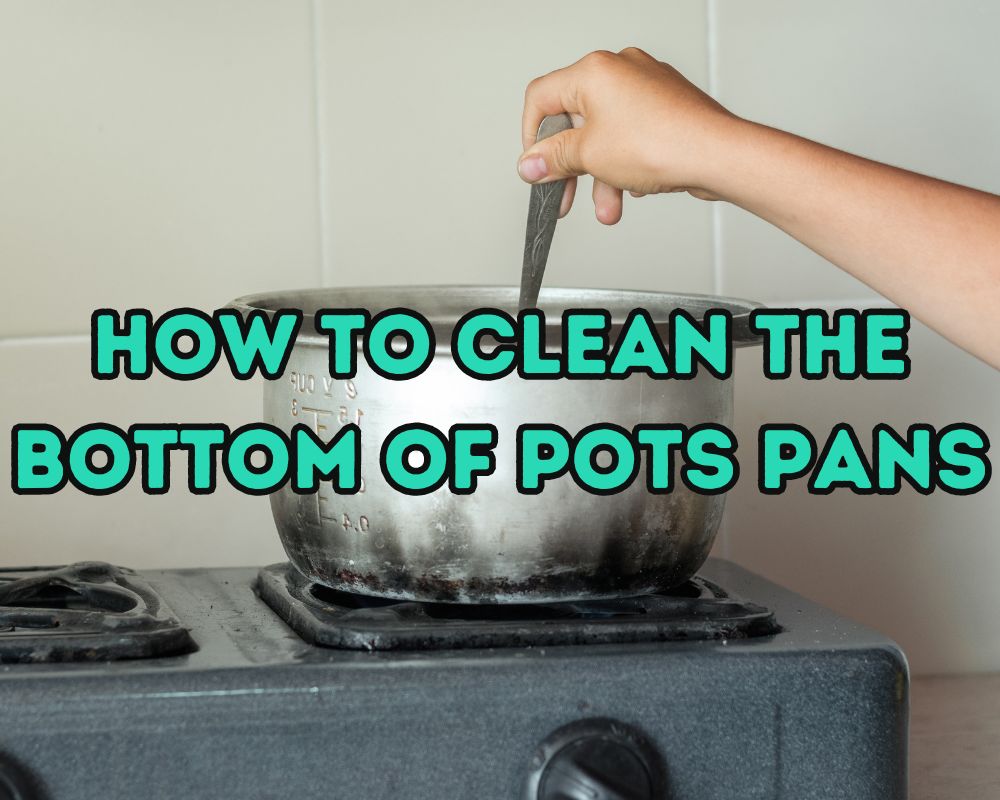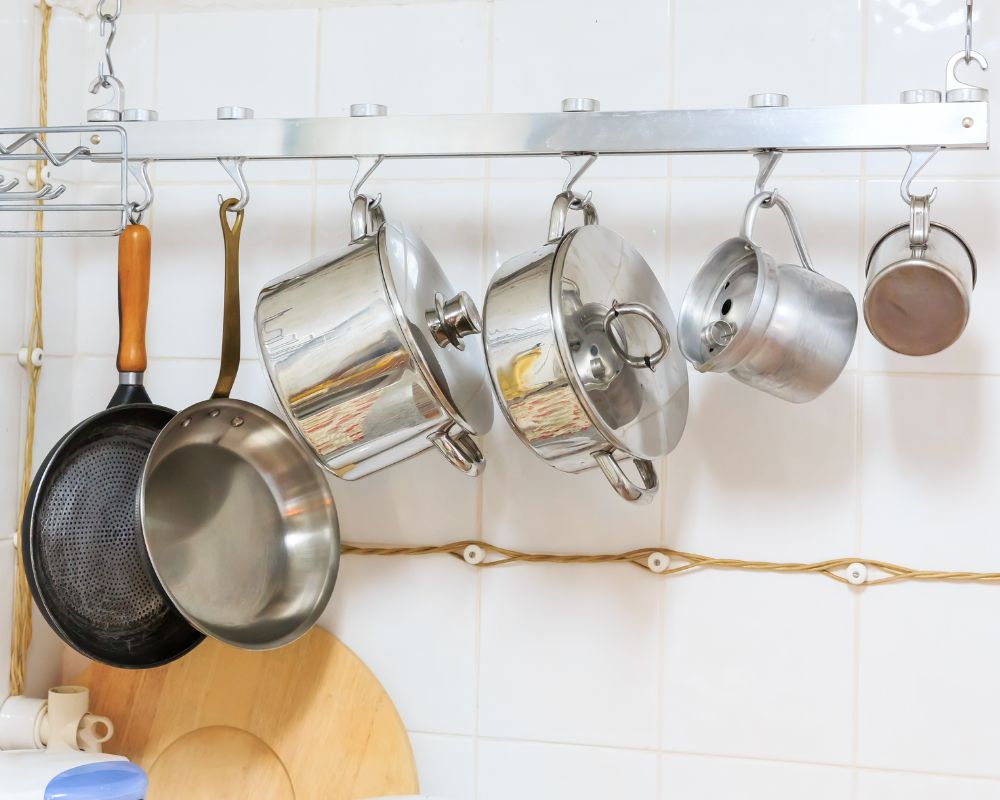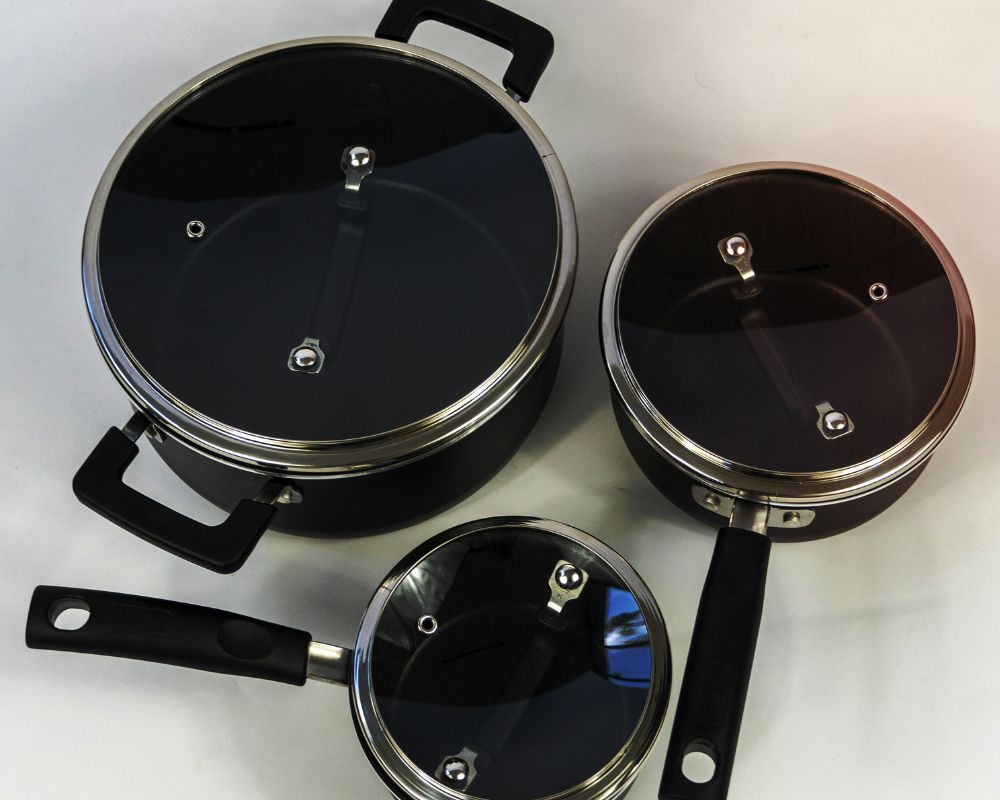Top Guide: How to Clean the Bottom of Pots and Pans Effortlessly

How to clean the bottom of pots pans. Are you tired of struggling to remove stubborn stains and burnt residue from the bottom of your pots and pans? Do you find it challenging to clean greasy residue and maintain the cleanliness of your cookware? Look no further! This comprehensive guide will provide easy and effective methods to clean the bottom of your pots and pans.
Whether you need to remove stains, scrub burnt residue, or clean stainless steel pans, this guide covers you. You will learn to deep clean kitchen pots, remove greasy residue, and discover non-toxic ways to clean your cookware. Additionally, you will find valuable tips on maintaining clean pots and pans and the best techniques to clean them efficiently.
So, if you want to restore the shine and cleanliness of your cookware effortlessly, keep reading to learn the best ways to clean the bottom of your pots and pans.
Table of Contents
Understanding Different Types of Cookware Materials

Before diving into the cleaning process, it’s essential to understand the different types of cookware materials to ensure you choose the right technique to clean them effectively. This section will focus on stainless steel pans and how to clean them.
Stainless Steel Pans
Stainless steel pans are durable, rust-resistant, and non-reactive, making them an excellent choice for cooking. However, they can be prone to discoloration and develop stains and burnt residue over time. It’s important to use the proper cleaning technique to prevent damaging the surface and preserve the longevity of your cookware.
Here’s how to clean stainless steel pans:
- Fill the pan with hot, soapy water and allow it to soak for at least an hour.
- Use a non-abrasive scrubber or sponge to remove any food residue or stains gently.
- If there are any stubborn spots, try making a paste of baking soda and water and apply it to the stains. Let it sit for about an hour before scrubbing and rinsing.
- Add some vinegar to a cloth and wipe the pan’s surface to restore the shine.
- Rinse thoroughly with water and dry with a soft cloth.
Avoid using harsh abrasive cleaners, bleach, or steel wool, as they can scratch and damage the surface of the stainless steel pan.
Preparing the Cookware for Cleaning
To achieve the best cleaning results, it’s essential to properly prepare your pots and pans before beginning the cleaning process. Follow these steps to prepare your cookware:
- Allow the Cookware to Cool Down: Before cleaning your pots and pans, ensure they have cooled down. Cleaning hot cookware can cause damage and make the cleaning process more difficult.
- Remove Any Leftover Food: Use a spatula or scraper to remove any leftover food from the bottom of your pots and pans. This will help prevent the food from burning onto the cookware during cleaning.
- Rinse with Hot Water: Rinse your pots and pans to remove loose residue. This will also help soften any burnt-on food, making removing it easier.
- Soak the Cookware: For tough stains and burnt-on residue, soak the cookware in hot water mixed with dish soap for at least 30 minutes. This will help to loosen the residue, making it easier to scrub off.
By following these preparation steps, you’ll be able to clean your cookware more effectively, ensuring an effortless and efficient cleaning process.
Non-Toxic Cleaning Methods for Cookware
Cleaning your cookware doesn’t have to mean using harsh chemicals. There are many natural and non-toxic ways to clean your pots and pans, which are better for the environment and your health.
1. Baking Soda and Vinegar
Baking soda and vinegar are the most effective ingredients for cleaning cookware. First, sprinkle a generous amount of baking soda onto the bottom of your pan to use these natural ingredients. Then, pour vinegar over the baking soda until it begins to fizz. Let the mixture sit for a few minutes before scrubbing the pan with a scrub brush or non-abrasive sponge.
2. Lemon Juice and Salt
Lemon juice and salt are also great for cleaning pots and pans. The acidity in the lemon juice helps break down grease and grime, while the salt is an abrasive to scrub away tough stains. Cut a lemon in half, dip it in salt, and use it to scrub the bottom of your pan.
3. Coca-Cola
Believe it or not, Coca-Cola can be used to clean your cookware. The soda’s acidity helps break down tough stains and burnt-on residue. To use Coca-Cola to clean your pots and pans, pour it into the bottom of the pan and let it sit for a few minutes. Then, use a scrub brush or non-abrasive sponge to remove the stains.
Using these non-toxic cleaning methods can help keep your cookware in top condition without harsh chemicals. Not only will your pots and pans be clean and shiny, but you’ll also have the peace of mind that comes with using safer, more natural cleaning methods.
Removing Stubborn Stains and Burnt Residue

Stubborn stains and burnt residue can be a headache to remove from the bottom of your cookware. However, with the right techniques and products, you can get them looking spotless once again.
To remove stains from cookware:
- Start by soaking the affected area in hot water. Add a tablespoon of dish soap or baking soda to the water to help break down the stain.
- After about 10 minutes, scrub the area with a non-abrasive pad.
- For tougher stains, try using a mixture of vinegar and baking soda or a commercial cleaner designed for the specific type of cookware.
When scrubbing burnt pots and pans, it’s essential to be gentle to avoid scratching the surface. Start by filling the pot or pan with hot water and adding a few drops of dish soap or white vinegar. Let it sit for a few minutes, then use a non-abrasive scrubber to remove the burnt residue. If there are any stubborn spots, try adding a paste of baking soda and water and let it sit for a few minutes before scrubbing.
It’s crucial to remember never to use steel wool or any other abrasive materials when scrubbing cookware. These can scratch the surface and damage the non-stick or glass coatings, reducing the lifespan of your pots and pans.
Pro Tip: To prevent future burnt residue, ensure that you don't leave your pots and pans unattended while cooking and never overheat the cookware.
Deep Cleaning Kitchen Pots and Pans
More than regular cleaning is needed to maintain the shine and cleanliness of your pots and pans. Deep cleaning is essential to remove hidden grime and hard-to-reach areas that can accumulate over time. Here are some steps to deep clean your kitchen pots and pans:
Step 1: Soak Cookware
Fill a sink or a large container with warm water and add a few drops of dish soap. Submerge your cookware and let it soak for about 30 minutes. This will help loosen any grime or burnt-on food.
Step 2: Scrub with Baking Soda
Baking soda is an excellent natural abrasive that can help remove any stubborn stains or burnt residue from your cookware. After soaking, sprinkle baking soda on the bottom of your pots and pans and scrub with a non-abrasive sponge or cloth. Rinse with warm water.
| Cookware Material | Recommended Cleaning Method |
|---|---|
| Stainless Steel | Baking soda and warm water |
| Cast Iron | Kosher salt and vegetable oil |
| Non-Stick | Mild dish soap and warm water |
Step 3: Use Vinegar for Stuck-on Residue
If the baking soda and water solution doesn’t remove all of the stuck-on residue, try using white vinegar. Fill the pot or pan with equal parts vinegar and water and bring to a boil. Reduce the heat and let it simmer for 10-15 minutes. Rinse with warm water and dry thoroughly.
Step 4: Polish with Olive Oil
To restore the shine of your stainless steel pots and pans, use a small amount of olive oil and a soft cloth to polish them. This will leave them looking as good as new.
By following these steps, you can ensure that your kitchen pots and pans are deep cleaned and maintained properly, enhancing their longevity and appearance.
- Fill a sink or container with warm water and dish soap to soak cookware.
- Scrub with baking soda and a non-abrasive sponge or cloth.
- Use vinegar for stuck-on residue and polish with olive oil to restore the shine of stainless steel cookware.
Removing Greasy Residue from Cookware
Greasy residues on the bottom of pots and pans can be frustrating and tough to remove, but with the right techniques, it can be an easy task. Here are some practical ways to remove greasy build-up from your cookware.
Method 1: Baking Soda and Vinegar Solution
A baking soda and vinegar solution is one of the most effective, non-toxic ways to clean greasy residue. Here is how to create it:
| What You Need: | Steps: |
|---|---|
| Baking soda | 1. Sprinkle baking soda on the greasy residue |
| Vinegar | 2. Add vinegar to the baking soda and let it sit for 10-15 minutes |
| Scrub brush | 3. Scrub the residue with a scrub brush |
| Water | 4. Rinse the cookware with water and dry it completely |
This solution effectively removes even the toughest grease stains from your cookware.
Method 2: Salt and Lemon Juice
If you prefer a more natural approach, use salt and lemon juice instead of harsh chemicals. Here’s how:
| What You Need: | Steps: |
|---|---|
| Salt | 1. Sprinkle salt on the greasy residue |
| Lemon juice | 2. Squeeze fresh lemon juice on top of the salt |
| Scrub brush | 3. Scrub the residue with a scrub brush |
| Water | 4. Rinse the cookware with water and dry it completely |
This method is also effective and leaves a pleasant lemon scent on your cookware.
Tips to Consider
Here are additional tips to consider to remove greasy residue from your cookware effectively:
- Use a soft sponge or brush to prevent damaging your cookware
- Do not use steel wool or abrasive sponges on non-stick cookware
- Clean your cookware immediately after use to prevent grease from hardening on the surface
By following these tips and using the appropriate cleaning methods, you can remove greasy residue from your cookware and keep it looking new for longer.
Tips for Maintaining Clean Cookware

Keeping your pots and pans clean and in good condition requires effort, but with a few simple cleaning tips, you can easily maintain their shine and longevity. Here are some effective cleaning tips for pots and pans:
Clean Your Cookware After Each Use
One of the most important things you can do to maintain clean cookware is to clean them after each use. Leaving food residue in your pots and pans can lead to stubborn stains and burnt-on grime, making them much more challenging to clean later.
Use the Right Cleaning Tools
Using the right cleaning tools is crucial to avoid scratching or damaging your pots and pans. A non-abrasive sponge or cloth and mild detergent are usually all you need to remove most stains and grime. Avoid using harsh chemicals or metal scouring pads that can scratch your cookware’s surface.
Soak Your Cookware
Soaking your pots and pans in warm, soapy water can help to loosen any stubborn stains or burnt-on food. Add a cup of white vinegar to the water for tough stains to help break down the grime.
Avoid High Heat
High heat can cause your cookware to warp or discolor over time. If you’re cooking with high heat, use only stainless steel or cast iron pans to withstand high temperatures. Also, avoid heating an empty pan on high heat, leading to warping, discoloration, and damage.
Store Your Cookware Properly
Proper storage of your cookware is essential to keep them in good condition. Avoid stacking your pots and pans on top of each other, which can cause scratches and damage to the surface. Instead, hang them on a rack or store them in a cabinet with a protective liner between each piece to prevent scratches.
By following these simple cleaning tips for pots and pans, you can maintain the cleanliness and longevity of your cookware, ensuring that they remain in pristine condition for years to come.
Best Techniques for Cleaning Pots and Pans
By following these techniques, you can easily clean the bottom of your pots and pans and keep them looking like new:
1. Determine the Material
Before cleaning your cookware, make sure you know the material it is made of. Different materials require different cleaning techniques to prevent damage. Refer to Section 2 for a better understanding of cookware materials.
2. Prep Your Cookware
Properly preparing your pots and pans before cleaning can make all the difference. Refer to Section 3 for detailed instructions on how to prepare your cookware for cleaning.
3. Use Non-Toxic Cleaning Methods
Consider using natural cleaning agents to prevent damage to your cookware. Refer to Section 4 for non-toxic cleaning solutions.
4. Remove Stubborn Stains and Burnt Residue
Use an appropriate cleaning agent and technique to remove stubborn stains and burnt residue. Refer to Section 5 for effective techniques and products.
5. Deep Clean Your Cookware Regularly
Regularly cleaning your kitchen pots and pans can help maintain their longevity and appearance. Refer to Section 6 for tips on deep cleaning.
6. Remove Greasy Residue Effectively
Greasy residue can be tough to remove, but following the proper techniques can make it a breeze. Refer to Section 7 for effective tips and techniques.
7. Implement Maintenance Tips
Prevent stains and grime from building up on the bottom of your pots and pans by following maintenance tips. Refer to Section 8 for valuable tips on maintaining clean cookware.
By incorporating these techniques, you can clean the bottom of your pots and pans effortlessly and maintain their cleanliness over time, saving you time and money in the long run.


